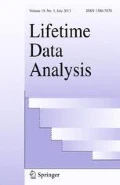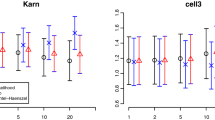Abstract
Many biological and medical studies have as a response of interest the time to occurrence of some event,X, such as the occurrence of cessation of smoking, conception, a particular symptom or disease, remission, relapse, death due to some specific disease, or simply death. Often it is impossible to measureX due to the occurrence of some other competing event, usually termed a competing risk. This competing event may be the withdrawal of the subject from the study (for whatever reason), death from some cause other than the one of interest, or any eventuality that precludes the main event of interest from occurring. Usually the assumption is made that all such censoring times and lifetimes are independent. In this case one uses either the Kaplan-Meier estimator or the Nelson-Aalen estimator to estimate the survival function. However, if the competing risk or censoring times are not independent ofX, then there is no generally acceptable way to estimate the survival function. There has been considerable work devoted to this problem of dependent competing risks scattered throughout the statistical literature in the past several years and this paper presents a survey of such work.
Similar content being viewed by others
References
O. Aalen, “Nonparametric Estimation of Partial Transition Probabilities in Multiple Decrement Models,”Annals of Statistics vol. 6 pp. 534–545, 1978.
P. K. Andersen, O. Borgan, R. D. Gill, and N. Keiding,Statistical Models Based on Counting Processes, Springer-Verlag: New York, 1993.
A. P. Basu and J. P. Klein, “Some Recent Results in Competing Risks Theory,” inSurvival Analysis (J. Crowley and R. A. Johnson, eds.), Hayward, California, 1982, pp. 216–229.
J. Benichou and M. H. Gail, “Estimates of Absolute Cause-Specific Risk in Cohort Studies,”Biometrics vol. 46 pp. 813–826, 1990.
S. M. Berman, “Notes on Extreme Values, Competing Risks, and Semi-Markov Processes,”Annals of Mathematical Statistics vol. 34 pp. 1104–06, 1963.
C. L. Chiang,Introduction to Stochastic Processes in Biostatistics, Wiley: New York, 1968.
C. L. Chiang, “Competing Risks and Conditional Probabilities,”Biometrics vol. 26 pp. 767–776, 1970.
D. G. Clayton, “A Model for Association on Bivariate Life Tables and Its Applications in Epidemiological Studies of Familial Tendency in Chronic Disease Incidence,”Biometrika vol. 65 pp. 141–151, 1978.
D. R. Cox, “The Analysis of Exponentially Distributed Lifetimes with Two Types of Failure,”Journal of the Royal Statistical Society Series B vol. 21 pp. 411–421, 1959.
D. R. Cox,Renewal Theory, Methuen: London, 1962.
D. R. Cox, “Regression Models and Life Tables (with Discussion),”Journal of the Royal Statistical Society Series B vol. 34 pp. 187–202, 1972.
D. R. Cox and D. Oakes,Analysis of Survival Data. Chapman and Hall: London, 1984.
Crowder, M. “On the Identifiability Crisis in Competing Risks Analysis,”Scandinavian Journal of Statistics vol. 18 pp. 223–233, 1991.
H. A. David and M. L. Moeschberger,The Theory of Competing Risks, Griffin: High Wycombe, 1978.
J. J. Dignam, L. A. Weissfeld, and S. J. Anderson, “Methods for Bounding the Marginal Survival Distribution,” Technical Report-Methods #15. Department of Biostatistics, University of Pittsburgh, Pittsburgh, PA, 1994.
L. Fisher and P. Kanarek, “Presenting Censored Survival Data When Censoring and Survival Times May Not be Independent,” inReliability and Biometry: Statistical Analysis of Lifelength (F. Proschan and R. Serfling, eds.), SIAM: Philadelphia, PA, 1974, pp. 303–326.
M. Frechét, “Sur les tableaux de correlation dont les marges sonte données.”Annales de l'Université de Lyon, Section A, Series 3 Vol. 14, pp. 53–77, 1951.
M. Gail, “A Review and Critique of Some Models Used in Competing Risk Analyses,”Biometrics vol. 31 pp. 209–222, 1975.
J. J. Gaynor, E. J. Feuer, C. C. Tan, D. H. Wu, C. R. Little, D. J. Straus, B. D. Clarkson, and M. F. Brennan, “On the Use of Cause-Specific Failure and Conditional Failure Probabilities: Examples from Clinical Oncology Data,”Journal of the American Statistical Association vol. 88 pp. 400–409, 1993.
R. J. Gray, “A Class ofk-Sample Tests for Comparing the Cumulative Incidence of a Competing Risk,”The Annals of Statistics vol. 16 no. 3 pp. 1141–1154, 1988.
J. J. Heckman and B. E. Honore, “The Identifiability of the Competing Risks Model,”Biometrika vol. 76 no. 2 pp. 325–330, 1989.
D. R. Hoover and F. M. Guess, “Response Linked Censoring: Modeling and Estimation,”Biometrika vol. 77 pp. 893–896, 1990.
P. Hougaard, “A Class of Multivariate Failure Time Distributions,”Biometrika vol. 73 pp. 671–678, 1986.
J. D. Kalbfleisch and R. L. Prentice,The Statistical Analysis of Failure Time Data Wiley: New York, 1980.
E. L. Kaplan and P. Meier, “Nonparametric Estimation from Incomplete Observations,”Journal of the American Statistical Association vol. 53 pp. 457–481, 1958.
A. W. Kimball, “Disease Incidence Estimation in Populations Subject to Multiple Causes of Death,”Bull. Int. Inst. Statist. vol. 36 pp. 103–204, 1958.
A. W. Kimball, “Models for the Estimation of Competing Risks from Grouped Data,”Biometrics vol. 25 pp. 329–337, 1969.
A. W. Kimball, “Model I vs. Model II in Competing Risk Theory,”Biometrics vol. 27 pp. 462–465, 1971.
J. P. Klein and M. L. Moeschberger, “Asymptotic Bias of the Product Limit Estimator under Dependent Competing Risks,”Indian Journal of Productivity, Reliability and Quality Control vol. 9 pp. 1–7, 1984.
J. P. Klein and M. L. Moeschberger, “Consequences of Assuming Independence in a Bivariate Exponential Series System,”IEEE Transactions on Reliability vol. R-35 pp. 330–335, 1986.
J. P. Klein and M. L. Moeschberger, “Independent or Dependent Competing Risks: Does It Make a Difference?,”Communications in Statistics-Computation and Simulation vol. 16(2) pp. 507–533, 1987.
J. P. Klein and M. L. Moeschberger, “Bounds on Net Survival Probabilities for Dependent Competing Risks,”Biometrics vol. 44 pp. 529–538, 1988.
J. Klein, M. Moeschberger, Y. Li, and S. Wang, “Estimating Random Effects in the Framingham Heart Study,”Survival Analysis: State of the Art (J. P. Klein and P. K. Goel, eds.), Kluwer Academic Publishers: Boston, 1992, pp. 99–120.
E. L. Korn and F. J. Dorey, “Applications of Crude Incidence Curves,”Statistics in Medicine vol. 11 pp. 813–829. 1992.
S. W. Lagakos, “General Right-Censoring and Its Impact on the Analysis of Survival Data,”Biometrics vol. 35 pp. 139–156, 1979.
S. W. Lagakos and J. S. Williams, “Models for Censored Survival Analysis: A Cone Class of Variable-Sum Models,”Biometrika vol. 65 pp. 181–189, 1978.
W. A. Link, “A Model for Informative Censoring,”Journal of the American Statistical Association vol. 84 pp. 749–752, 1989.
M. L. Moeschberger, “Life Tests Under Dependent Competing Causes of Failure,”Technometrics vol. 16 pp. 39–47, 1974.
M. L. Moeschberger and J. P. Klein, “Consequences of Departures from Independence in Exponential Series Systems,”Technometrics vol. 26 pp. 277–284, 1984.
W. Nelson, “Theory and Applications of Hazard Plotting for Censored Failure Data,”Technometrics vol. 14 pp. 945–966, 1972.
D. Oakes, “A Concordance Test for Independence in the Presence of Censoring,”Biometrics vol. 38 pp. 451–455, 1982.
M. S. Pepe, “Inference for Events with Dependent Risks in Multiple Endpoint Studies,”Journal of the American Statistical Association vol. 86 pp. 770–778, 1991.
M. S. Pepe and M. Mori, “Kaplan-Meier, Marginal or Conditional Probability Curves in Summarizing Competing Risks Failure Time Data?”Statistics in Medicine vol. 12 pp. 737–751, 1993.
A. V. Peterson, “Bounds for a Joint Distribution Function with Fixed Sub-Distribution Functions: Applications to Competing Risks,”Proceedings of the National Academy of Sciences vol. 73 pp. 11–13, 1976.
R. L. Prentice, J. D. Kalbfleisch, A. V. Peterson, N. Flournoy, V. T. Farewell, and N. E. Breslow, “The Analysis of Failure Time Data in the Presence of Competing Risks,”Biometrics vol. 34 pp. 541–554, 1978.
J. M. Robins, “Analytic Methods for Estimating HIV-Treatment and Cofactor Effects,” InMethodological Issues in AIDS Research (D. G. Ostrow and R. C. Kessler, eds.), Plenum: New York, 1993, pp. 213–290.
J. M. Robins, “Estimation of the Time-Dependent Accelerated Failure Time Model in the Presence of Confounding Factors,”Biometrika vol. 79 pp. 321–34, 1992.
E. Slud, “Nonparametric Identifiability of Marginal Survival Distributions in the Presence of Dependent Competing Risks and a Prognostic Covariate,” inSurvival Analysis: State of the Art (J. P. Klein and P. K. Goel, eds.), Kluwer Academic Publishers: Boston, 1992, pp. 355–368.
E. V. Slud and D. Byar, “How Dependent Causes of Death can Make Risk Factors Appear Protective,”Biometrics vol. 44 pp. 265–269, 1988.
E. V. Slud, D. Byar, and A. Schatzkin, “Dependent Competing Risks and the Latent-Failure Model,”Biometrics vol. 44 pp. 1203–1205, 1988.
E. V. Slud and L. V. Rubinstein, “Dependent Competing Risks and Summary Survival Curves,”Biometrika vol. 70 pp. 643–649, 1983.
A. Tsiatis, “A Nonidentifiability Aspect of the Problem of Competing Risks,”Proceedings of the National Academy of Sciences USA, vol. 72 pp. 20–22, 1975.
J. S. Williams and S. W. Lagakos, “Models for Censored Survival Analysis: Constant-Sum and Variable-Sum Models,”Biometrika vol. 64 pp. 215–224, 1977.
M. Zheng and J. P. Klein, “Estimates of Marginal Survival for Dependent Competing Risks Based on an Assumed Copula,”Biometrika vol. 82, pp. 127–138, 1995.
M. Zheng and J. P. Klein. “A Self-Consistent Estimator of Marginal Survival Functions Based on Dependent Competing Risk Data and an Assumed Copula,”Communication in Statistics-Theory and Methods vol. 23(8), pp. 2299–2311, 1994a.
M. Zheng and J. P. Klein, “Identifiability and Estimation of Marginal Survival Functions for Dependent Competing Risks Assuming the Copula is Known,”1994 International Research Conference on Lifetime Data Models in Reliability and Survival Analysis, Boston, 1994b.
Author information
Authors and Affiliations
Rights and permissions
About this article
Cite this article
Moeschberger, M.L., Klein, J.P. Statistical methods for dependent competing risks. Lifetime Data Anal 1, 195–204 (1995). https://doi.org/10.1007/BF00985770
Received:
Accepted:
Issue Date:
DOI: https://doi.org/10.1007/BF00985770




